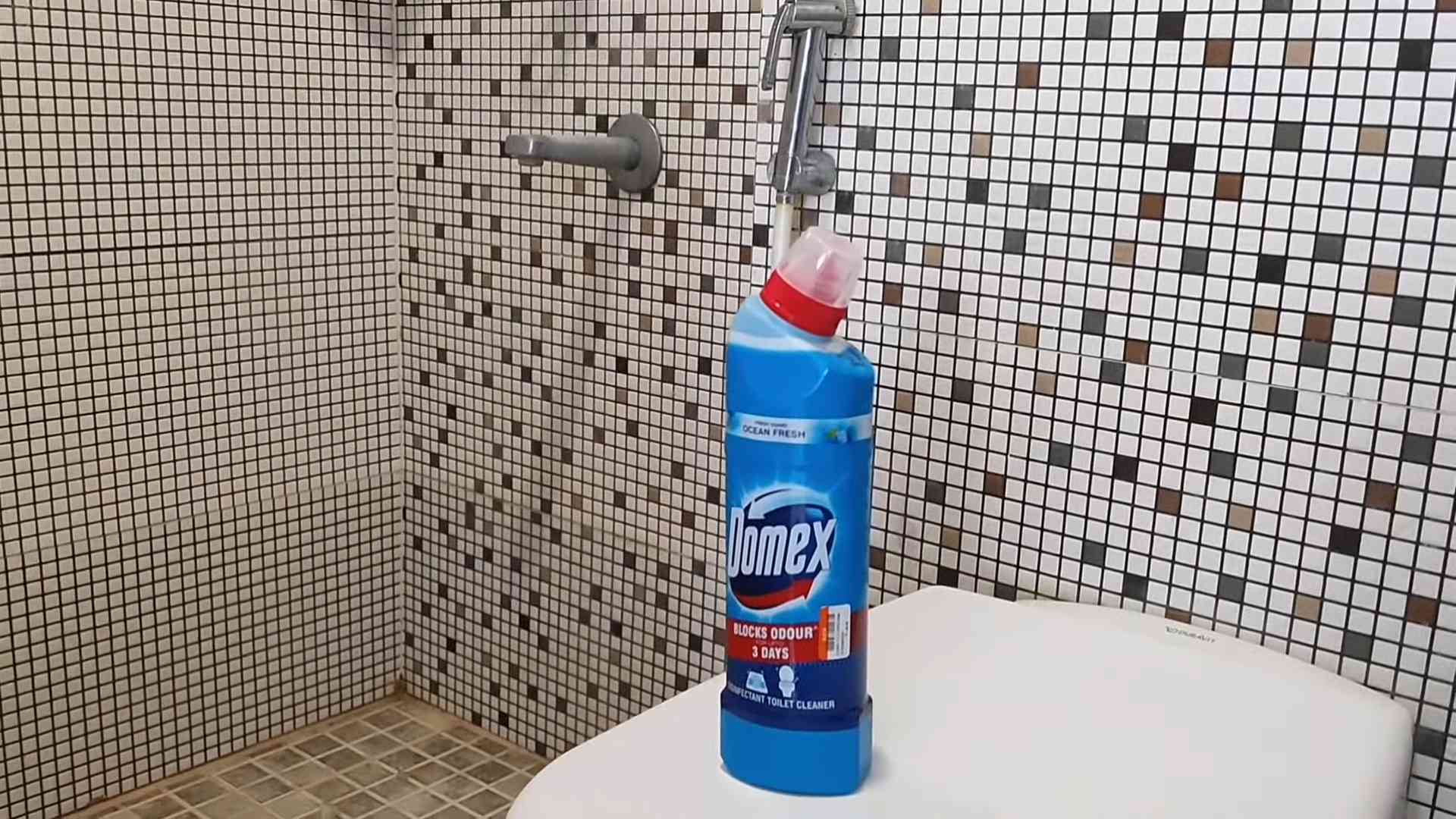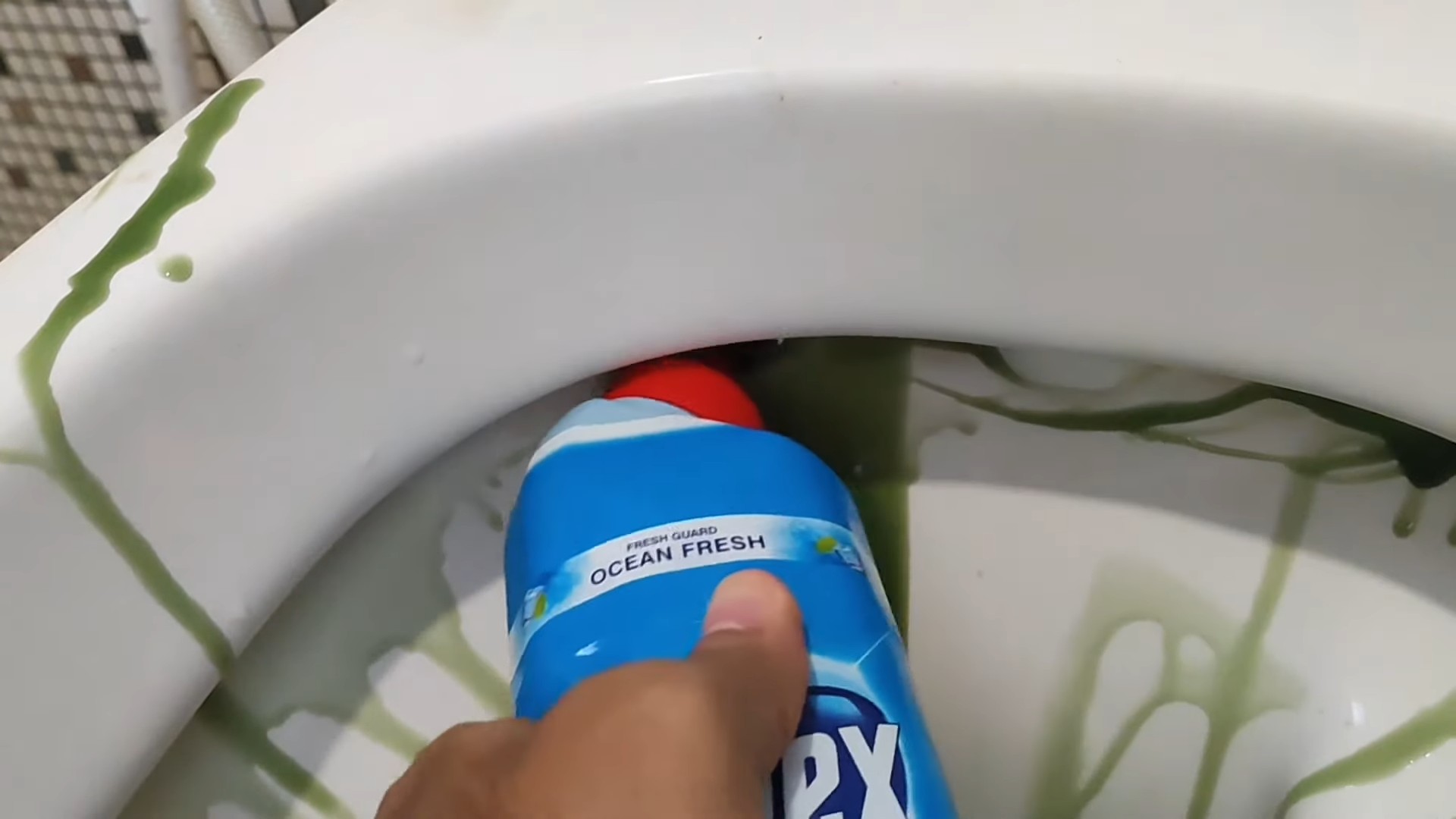Whitening toilets with Domex might sound like a chore, but trust me, it’s a game-changer for your bathroom! We’ve all been there, staring into a toilet bowl that’s seen better days, wondering how to restore its sparkling glory. Before the days of readily available commercial cleaners like Domex, people relied on natural remedies like vinegar and baking soda – a testament to our enduring quest for a clean and fresh home.
But let’s be honest, sometimes those natural solutions just don’t cut it, especially when dealing with stubborn stains and grime. That’s where this DIY trick comes in. I’m going to show you a simple, effective method for whitening toilets with Domex that will leave your bathroom looking and feeling brand new. No more embarrassing stains or lingering odors! This isn’t just about aesthetics; a clean toilet is a hygienic toilet, contributing to a healthier home environment for you and your family. So, grab your gloves, and let’s get started on this easy DIY project that will make a world of difference!

DIY Toilet Whitening Hack: Banishing Stains with Domex (and a Little Elbow Grease!)
Okay, let’s face it: nobody *loves* cleaning the toilet. But a sparkling white toilet bowl? That’s something we can all appreciate. I’ve tried countless methods over the years, from fancy cleaners to natural remedies, and I’ve found a simple, effective, and relatively inexpensive way to get my toilets looking their best: Domex.
This guide will walk you through my tried-and-true method for whitening your toilet bowl using Domex bleach. It’s not just about pouring and flushing; it’s about strategic application and a little bit of patience. Let’s get started!
What You’ll Need:
* Domex bleach (or your preferred bleach-based toilet cleaner)
* Toilet brush
* Rubber gloves (essential!)
* Eye protection (optional, but recommended)
* Old toothbrush (for those hard-to-reach spots)
* Paper towels or a sponge
* Well-ventilated area (open a window or turn on the exhaust fan)
* A little bit of time (at least 30 minutes, longer for stubborn stains)
Safety First!
Before we dive in, let’s talk safety. Bleach is a powerful chemical, and it’s important to handle it with care.
* Always wear rubber gloves to protect your skin. Bleach can cause irritation and dryness.
* Consider eye protection. Splashes happen! Safety glasses or goggles are a good idea.
* Ensure good ventilation. Open a window or turn on the exhaust fan to avoid inhaling fumes.
* Never mix bleach with other cleaning products, especially ammonia. This can create dangerous and toxic gases.
* Keep bleach out of reach of children and pets.
Step-by-Step Instructions:
1. Prepare the Toilet Bowl:
* Flush the toilet to remove any loose debris.
* Lower the water level as much as possible. You can do this by slowly pouring a bucket of water into the bowl to trigger a flush, or by using a plunger to push the water down. The less water in the bowl, the more concentrated the bleach will be.
2. Apply Domex Generously:
* Carefully pour Domex bleach around the entire rim of the toilet bowl. Aim for a generous, even coating so that the bleach runs down the sides and covers all stained areas.
* Pay special attention to the area under the rim, where stains often accumulate. You might need to angle the bottle or use the nozzle to reach these spots.
* For particularly stubborn stains, I like to squirt a little extra Domex directly onto the affected area.
3. Let it Soak (The Key to Success!):
* This is the most important step! Let the Domex soak in the toilet bowl for at least 30 minutes. For heavily stained toilets, I recommend letting it soak for several hours, or even overnight. The longer the bleach sits, the more time it has to break down the stains.
* I usually do this before I go to bed, so the bleach can work its magic while I sleep. Just be sure to inform everyone in the household that the toilet is out of commission!
4. Scrub-a-Dub-Dub:
* After the soaking period, it’s time to scrub! Use your toilet brush to thoroughly scrub the entire bowl, paying close attention to the stained areas.
* Don’t be afraid to put some elbow grease into it! The longer the Domex has soaked, the easier the stains will come off.
* For those hard-to-reach spots under the rim, use your old toothbrush. This will allow you to get into those tight corners and scrub away any remaining grime.
5. Flush and Inspect:
* Flush the toilet to rinse away the bleach and loosened stains.
* Inspect the bowl to see if any stains remain. If so, repeat steps 2-4. You might need to do this a few times for really stubborn stains.
6. Clean the Exterior:
* While you’re at it, don’t forget to clean the exterior of the toilet! Use a paper towel or sponge dampened with a diluted bleach solution (a small amount of Domex mixed with water) to wipe down the seat, lid, tank, and base of the toilet.
* Be sure to rinse thoroughly with clean water to remove any bleach residue.
7. Admire Your Sparkling Toilet!
* Step back and admire your sparkling clean toilet bowl! It’s amazing what a little bleach and elbow grease can do.
Dealing with Stubborn Stains:
Sometimes, you’ll encounter stains that just won’t budge, no matter how much you scrub. Here are a few tips for dealing with those stubborn stains:
* Pumice Stone: A pumice stone can be very effective for removing hard water stains and mineral deposits. Wet the pumice stone and gently rub it on the stained area. Be careful not to scratch the porcelain! Test it in an inconspicuous area first.
* Baking Soda and Vinegar Paste: Make a paste of baking soda and vinegar and apply it to the stain. Let it sit for 30 minutes, then scrub and rinse. This is a more natural alternative to bleach.
* CLR (Calcium, Lime, Rust Remover): CLR is a commercial cleaner specifically designed to remove hard water stains and mineral deposits. Follow the instructions on the bottle carefully.
* Repeat the Process: Sometimes, all it takes is another round of soaking and scrubbing. Don’t give up!
Maintaining a White Toilet Bowl:
Once you’ve achieved a sparkling white toilet bowl, you’ll want to keep it that way! Here are a few tips for maintaining a clean and stain-free toilet:
* Regular Cleaning: Clean your toilet bowl at least once a week to prevent stains from building up.
* Toilet Bowl Cleaner: Use a toilet bowl cleaner regularly to help prevent stains and keep your toilet smelling fresh.
* Toilet Bowl Tablets: Drop a toilet bowl tablet into the tank to help keep the water clean and prevent stains.
* Flush Regularly: Flush the toilet after each use to prevent stains from setting.
* Address Leaks: Fix any leaks promptly to prevent hard water stains from forming.
Troubleshooting:
* Bleach Smell: If the bleach smell is too strong, make sure you have adequate ventilation. You can also try adding a few drops of essential oil (like lemon or eucalyptus) to the toilet bowl after cleaning.
* Stains Not Lifting: If the stains aren’t lifting, try soaking the toilet bowl for a longer period of time. You can also try using a stronger bleach solution.
* Porcelain Damage: Be careful not to scratch the porcelain when scrubbing. Use a non-abrasive cleaner and a soft brush.
Alternative Cleaning Solutions (If You’re Bleach-Averse):
While Domex is my go-to for whitening, I understand some people prefer to avoid bleach. Here are a few alternative solutions you can try:
* Vinegar: Pour a cup of white vinegar into the toilet bowl and let it sit overnight. Scrub and flush in the morning.
* Baking Soda: Sprinkle a cup of baking soda into the toilet bowl and let it sit for an hour. Scrub and flush.
* Borax: Sprinkle a cup of borax into the toilet bowl and let it sit overnight. Scrub and flush in the morning.
* Lemon Juice: Pour a cup of lemon juice into the toilet bowl and let it sit for an hour. Scrub and flush.
These natural alternatives may not be as powerful as bleach, but they can be effective for removing mild stains and keeping your toilet bowl clean.
Final Thoughts:
Cleaning the toilet is never a fun chore, but with this method, it doesn’t have to be a dreaded one. By using Domex bleach strategically and following these steps, you can achieve a sparkling white toilet bowl that you’ll be proud of. Remember to always prioritize safety and take your time. Happy cleaning!

Conclusion
So, there you have it! Transforming your dingy toilet into a sparkling throne doesn’t require expensive cleaners or harsh chemicals. This simple DIY trick using Domex is a game-changer for anyone seeking a brighter, cleaner bathroom without breaking the bank or exposing themselves to unnecessary toxins. We’ve shown you how to harness the power of Domex in a way that maximizes its whitening potential, leaving your toilet bowl gleaming and fresh.
Why is this a must-try? Because it’s effective, affordable, and readily accessible. You likely already have Domex in your cleaning arsenal, making this a zero-cost experiment with potentially huge rewards. Imagine the satisfaction of seeing your toilet bowl looking brand new, reflecting a sense of cleanliness and hygiene throughout your entire bathroom. This isn’t just about aesthetics; it’s about creating a healthier and more pleasant living space.
But don’t stop there! Feel free to experiment with variations to personalize your toilet whitening routine. For instance, if you’re dealing with particularly stubborn stains, consider adding a tablespoon of baking soda to the Domex solution. The gentle abrasive action of baking soda can help lift away grime and discoloration. Alternatively, for a more fragrant clean, add a few drops of your favorite essential oil (tea tree, eucalyptus, or lavender are excellent choices for their antibacterial properties) to the toilet bowl after the Domex treatment. Just be sure to dilute the essential oil properly to avoid any potential damage to the porcelain.
Another variation involves the application method. While we’ve suggested pouring the Domex solution directly into the bowl, you could also try saturating toilet paper with the solution and applying it directly to the stained areas. This allows for more targeted treatment and can be particularly effective for tackling stubborn rings or waterline stains. Remember to wear gloves when handling Domex and to flush thoroughly after the treatment.
The key to success with this DIY toilet whitening method is consistency. While you’ll likely see a noticeable improvement after just one treatment, regular application (once or twice a week) will help maintain a bright, clean toilet bowl and prevent stains from building up in the first place. Think of it as part of your regular bathroom cleaning routine, just like wiping down the counters or cleaning the mirror.
We are confident that this DIY trick will revolutionize your toilet cleaning routine. It’s a simple, effective, and affordable way to achieve a sparkling clean toilet bowl using the power of Domex. Now it’s your turn! Give this method a try and see the amazing results for yourself. We encourage you to share your experiences with us in the comments below. Let us know what variations you tried, what challenges you encountered, and what tips you have for others. Your feedback is invaluable and will help us refine this method even further. Together, let’s banish dingy toilets and embrace a brighter, cleaner bathroom experience! Don’t forget to share this article with your friends and family who are also looking for effective and affordable toilet cleaning solutions. Let’s spread the word about this amazing DIY toilet whitening trick!
Frequently Asked Questions (FAQ)
What exactly makes Domex effective for whitening toilets?
Domex contains powerful bleaching agents that effectively break down and lift away stains, discoloration, and grime from the toilet bowl surface. These agents work by oxidizing the stain molecules, rendering them colorless and easier to remove. The formulation of Domex is specifically designed to cling to surfaces, allowing for extended contact time and enhanced cleaning power. This prolonged contact ensures that the bleaching agents have ample opportunity to penetrate and dissolve even the most stubborn stains. Furthermore, Domex often contains surfactants that help to loosen dirt and debris, making it easier to flush away. The combination of bleaching agents and surfactants makes Domex a highly effective solution for whitening toilets and restoring their original shine.
Is it safe to use Domex in my toilet? Will it damage the porcelain or plumbing?
When used as directed, Domex is generally safe for use in most toilets. However, it’s crucial to follow the instructions on the product label carefully. Avoid prolonged exposure of Domex to metal parts, as it can potentially cause corrosion over time. Always flush the toilet thoroughly after using Domex to remove any residual cleaner. If you have an older toilet with delicate porcelain, it’s advisable to test the Domex solution on a small, inconspicuous area first to ensure that it doesn’t cause any damage or discoloration. While Domex is generally safe for plumbing, excessive use or pouring large quantities down the drain can potentially disrupt the balance of beneficial bacteria in your septic system. Therefore, it’s best to use Domex in moderation and to follow the recommended dosage guidelines.
How often should I use this DIY toilet whitening method?
The frequency of application depends on the severity of the stains and the overall condition of your toilet. For toilets with light staining, a weekly or bi-weekly treatment may be sufficient to maintain a bright, clean appearance. For toilets with more stubborn stains or those that are prone to discoloration, you may need to apply the Domex solution more frequently, such as every few days. It’s important to monitor the condition of your toilet and adjust the frequency of application accordingly. Overuse of Domex can potentially damage the porcelain or plumbing, so it’s best to use it in moderation and to follow the recommended dosage guidelines.
What if I have a septic system? Is this method still safe to use?
While Domex can be used with septic systems, it’s important to do so cautiously and in moderation. The harsh chemicals in Domex can potentially disrupt the balance of beneficial bacteria in your septic tank, which are essential for breaking down waste. To minimize the impact on your septic system, use Domex sparingly and avoid pouring large quantities down the drain. Consider diluting the Domex solution with water before applying it to the toilet bowl. You can also look for septic-safe toilet cleaners that contain enzymes or bacteria that help to maintain the balance of your septic system. If you’re concerned about the impact of Domex on your septic system, it’s best to consult with a plumbing professional or septic system specialist for advice.
What are some alternative cleaning agents I can use if I don’t have Domex?
If you don’t have Domex on hand, there are several alternative cleaning agents you can use to whiten your toilet. Baking soda and vinegar are a classic combination that can effectively remove stains and odors. Simply sprinkle baking soda into the toilet bowl, then pour in vinegar. Let the mixture fizz for a few minutes, then scrub with a toilet brush and flush. Lemon juice is another natural cleaning agent that can help to brighten and deodorize your toilet. Pour lemon juice into the toilet bowl and let it sit for a few hours, then scrub and flush. Borax is a natural mineral that can also be used to whiten toilets. Sprinkle borax into the toilet bowl, let it sit for a few hours, then scrub and flush. For more stubborn stains, you can try using hydrogen peroxide or bleach. However, be sure to use these chemicals with caution and to follow the instructions on the product label carefully. Always wear gloves when handling cleaning agents and avoid mixing different chemicals together, as this can create dangerous fumes.
The stains in my toilet are really stubborn. What can I do to remove them?
For particularly stubborn stains, you may need to take a more aggressive approach. Try creating a paste of baking soda and water and applying it directly to the stained areas. Let the paste sit for several hours or even overnight, then scrub with a toilet brush and flush. You can also try using a pumice stone to gently scrub away stubborn stains. Be careful not to scratch the porcelain with the pumice stone. For extremely stubborn stains, you may need to resort to using a commercial toilet bowl cleaner that contains stronger chemicals. However, be sure to use these cleaners with caution and to follow the instructions on the product label carefully. Always wear gloves when handling cleaning agents and avoid mixing different chemicals together. If you’ve tried everything and the stains still won’t budge, it may be time to call a professional cleaning service.
Can I use this method on colored toilets?
While Domex is generally safe for use on most toilets, it’s best to exercise caution when using it on colored toilets. The bleaching agents in Domex can potentially fade or discolor the finish of colored toilets. To avoid any damage, test the Domex solution on a small, inconspicuous area of the toilet first to ensure that it doesn’t cause any discoloration. If the test area looks fine, you can proceed with applying the solution to the rest of the toilet bowl. However, be sure to use the Domex solution sparingly and to avoid prolonged exposure to the colored surface. Alternatively, you can use a milder cleaning agent that is specifically designed for colored toilets. These cleaners are typically less harsh than Domex and are less likely to cause fading or discoloration.
Is there a way to prevent stains from forming in my toilet in the first place?
Yes, there are several things you can do to prevent stains from forming in your toilet. First, flush the toilet regularly, especially after each use. This will help to prevent waste from sitting in the bowl and causing stains. Second, clean your toilet regularly, at least once a week. This will help to remove any buildup of dirt, grime, and stains before they become too difficult to remove. Third, use a toilet bowl cleaner that contains stain-fighting ingredients. These cleaners can help to prevent stains from forming and to keep your toilet bowl looking clean and fresh. Fourth, avoid using harsh chemicals or abrasive cleaners, as these can damage the





Leave a Comment